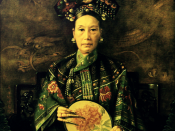The late Qing reforms introduced by the Empress Dowager in the decade
following the Boxer Rebellion were highly significant in leading China into a more
modern nation. The several reforms shaped the numerous aspects of Chinese society. The
reforms that were instituted fueled the fire that led to the Wuhan Rebellion in 1911 and
the fall of the Qing.
The major reforms that were introduced by the Empress dowager after the Boxer
Rebellions were reforms on education, the military, and constitutionalism. These reforms
were chosen because they were needed in china. The Chinese political infrastructure
needed to be renovated. China wanted to progress as a nation and looked towards their
neighbor Japan and Western sources for enlightenment.
The introduction of reforming the education system was one of great importance.
The curriculum that was introduced was modernized. The old Neo-Confucian orthodoxy
was old and needed to be abolished if the Chinese were to advance.
The old curriculum
required the reading of the Classics. This is in essence was useless to the Chinese in their
present time because it didn't teach them any practical knowledge. They could not use
the information learned in the Classics and apply them to the situations that they were
facing. Subjects that included math, philosophy, and science were introduced as
important subjects that needed to be studied.
Another important part of China was the exam system. The reform of this
system was also a mandate because of the changing wave of restructuring that
was taking place in China. Spence states, "Guangxu ordered the abolition of the highly
stylized format known as the "eight-legged essay," which had structured the exams for
centuries." The termination of this exam system was an excellent proposal because the
information that was stressed upon was becoming useless.
The school system was retrograded...


